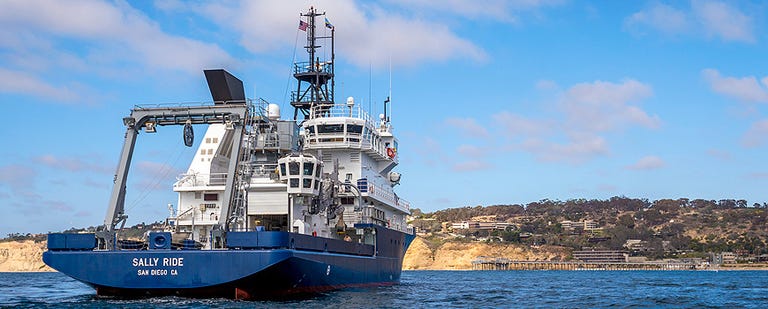NASA Is Stepping Into the Twilight Zone
Two research ships are going to the Pacific Ocean to figure out how tiny organisms play a big role in regulating the world' temperature.
By David Grossman
CRIPPS INSTITUTION OF OCEANOGRAPHY, UC SAN DIEGO
- Tiny ocean plankton pull carbon dioxide out of the air during photosynthesis and stash it in the deeper ocean when they die.
- NASA scientists want to study this "twilight zone" when the CO2 ends up to better understand how tiny organisms affect climate change.
- They're taking two boats rigged with scientific equipment to the Pacific Ocean to study the twilight zone.
Phytoplankton—tiny, plant-like organisms that live in the ocean—rarely make headlines. NASA and the National Science Foundation are hoping to change that with an expedition to the northeastern Pacific Ocean this August. The journey will hope to gain a better understanding of these small animals that could play an outsized role in removing carbon dioxide from the ocean.
More than 100 scientists and crew from more than 20 research foundations will travel aboard two research vessels, the R/V Roger Revelle and R/V Sally Ride. The Revelle carries complex machinery such as a Hydrographic Doppler Sonar System, a system with a hull-mounted long-range dual-frequency Doppler sonar that can detect currents stronger than anything commercially available. The Sally Ride, meanwhile, has top-notch ocean mapping systems.
The two vessels will sail 200 miles west towards open water. Once there, the scientists will examine plankton and look at the chemical and physical properties of the ocean from the surface to half a mile below—into what's known as the "twilight zone."
The twilight zone, also called the Mesopelagic zone, exists around 660 to 3300 feet below the surface. It's earned its name because a small amount of light penetrates the region, yet not enough for photosynthesis. Because not even algae can form there, the zone has become a place where carbon released by plankton can be sequestered for periods ranging from decades to thousands of years.
The phytoplankton themselves live above the twilight zone, residing in the sunlit upper ocean. There they perform photosynthesis using sunlight and carbon dioxide dissolved from the atmosphere into the ocean, producing oxygen as a result. That photosynthesis is one of the ways the ocean eliminates carbon dioxide on the planet. When phytoplankton die, their remains sink to the twilight zone, carrying some of their carbon with them.

The Pacific Ocean teems with phytoplankton along the West Coast of the United States, as captured by the MODIS instrument on NASA’s Aqua satellite. Satellites can track phytoplankton blooms, which occur when these plant-like organisms receive optimal amounts of sunlight and nutrients. Phytoplankton play an important role in removing atmospheric carbon dioxide
NASA
David Siegel, a lead scientist from the University of California, Santa Barbara, says in a press release:
"[The ships will] observe simultaneously the three basic mechanisms by which carbon is exported from the upper ocean to depth. We’re trying to better understand the biology and ecology of phytoplankton in the surface water, how those characteristics drive the transport of carbon to the twilight zone, and then what happens to the carbon in the deeper water.”
Siegel says scientists will glean significant data from the mission. "NASA's ocean color satellite record shows us these ecosystems are highly sensitive to climate variability. Changes in phytoplankton populations affect the marine food web since phytoplankton are eaten by many animal species big and small. The stakes are high.”
The ocean's long-term removal of organic carbon from the atmosphere is referred to as the biological pump, and this new study will provide data on this role of phytoplankton and plankton within this system. Of special interest will be how the remains of phytoplankton move with through currents in the twilight zone.
“What we will learn from EXPORTS will give us a deeper understanding of how plankton species and other microorganisms such as bacteria interact with their environment," says Paula Bontempi, program manager for Ocean Biology and Biogeochemistry at NASA Headquarters in a press statement. "Not only will we be able to use this information to develop new approaches to identifying and quantifying plankton species from space, we’ll be able to predict how much carbon will cycle back into the atmosphere and how much will be transported to the ocean depths for the long term.”
Source: NASA
No comments:
Post a Comment